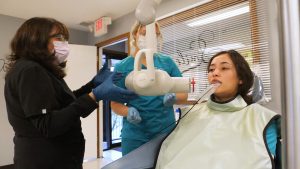10 Dental Instruments You Need To Know
April 22, 2015
Becoming Familiar with Instruments Included in Dental Assisting Program
It is essential that Dental Assistants develop an understanding of dental tools. Although only Dentists and Dental Hygienists actually use tools directly on patients, it is essential that students learn about instruments in the Dental Assisting program. Assistants are responsible for preparing instruments prior to an exam or procedure and may be called upon to hand an instrument to the Dentist or Hygienist.
Part of the training students receive in the Dental Assistant program includes developing a familiarity with dental instruments. Here’s a brief list of the most common types of dental instruments found in dental offices and their function.
- Burnishers – At the end of dental restoration, burnishers are used to remove scratches or smooth rough edges. This is a rotary tool, and like burs, it comes in several shapes.
- Drills – Used to cut into tooth enamel to remove tooth decay, drills utilize bits known as burs, which come in many shapes and sizes to allow the dentist to perform a variety of procedures.
- Elevators – Resembling a chisel with large handles and thin, flat tips, dentists use elevators to raise a tooth in its socket before extracting it.
- Excavators – These hand instruments are used to cut into teeth and remove decayed material. There are several types of dental excavators. Enamel hatchets are used to prepare cavity walls. Dental hatchets are used to widen the dental cavity. Spoon excavators are used to remove tooth debris and decayed material from the cavity.
- Explorers – Also known as a sickle probe, dental explorers have a slim handle with a small pointed hook at the end. They are used to probe or examine surfaces of teeth for soft areas which may indicate tooth decay.
- Forceps – Dental forceps look like pliers and are used to pull teeth. Dentists use a specific forceps made to fit around a different kind of tooth.
- Mirrors – Dentists and hygienists use small, angled mirrors to see hidden areas, including the backsides of teeth. They are also used to reflect light into areas of the mouth and throat to improve visibility.
- Retractors – Dental retractors are tools that allow hygienists and dentists to hold and spread parts of the mouth to improve visibility and permit physical access. There are different retractors designed to hold open cheeks, lips and tongue.
- Periodontal probes – A probe is straight and thin with a blunt end, used to measure the depth of the pocket between gums and teeth. Markings engraved on the top of the probe ensure accurate measurements.
- Periodontal Scalers and Curettes – In order to remove tartar from the tooth’s surface, dentists and hygienists use instruments with long, narrow tips. Scalers are used above the gum line while curettes are used below the gum line. Both come in a variety of shapes and sizes.
Are you interested in a Dental Assisting program?
First Institute offers comprehensive training that includes both clinical and administrative aspects of a dental practice. If you would like more information about Dental Assistant training in Illinois, contact us today. Call 815-459-3500.
Learn more about First Institute’s Dental Assisting program:

